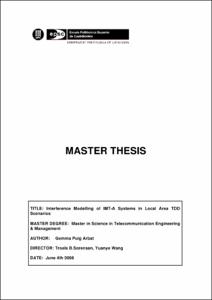Mostra el registre d'ítem simple
Interference modelling of IMT-A Systems in LA-TDD Scenarios
| dc.contributor | Ruiz Boqué, Sílvia |
| dc.contributor.author | Puig Arbat, Gemma |
| dc.contributor.other | Universitat Politècnica de Catalunya. Departament de Teoria del Senyal i Comunicacions |
| dc.date.accessioned | 2009-02-19T17:30:30Z |
| dc.date.available | 2009-02-19T17:30:30Z |
| dc.date.issued | 2008-06-04 |
| dc.identifier.uri | http://hdl.handle.net/2099.1/6133 |
| dc.description.abstract | Orthogonal Frequency Division Multiple Access( OFDMA) and Single Carrier Frequency Division Multiple Access( SC-FDMA), the access techniques used in DL and UL respectively in UTRAN LTE, are strong candidates also for IMT-A systems, namely 4G. IMT-A systems are expected to provide peak-data-rates in the order of 1Gbit=s in Local Area(LA) and 100Mbit=s in wide area[2]. Such high data rates re- quire techniques to achieve high spectral eficiency (bits=s=Hz) and very high spectrum allocation in the range of 100MHz. While Frequency Division Duplex( FDD) is extensively used in cur- rent systems, Time Division Duplex( TDD) has gradually attracted the research interests for its many advantages over the former. Net- work synchronization is more complicated in TDD than in FDD but this can be easily treated in local area (LA) scenarios. Therefore, the purpose of this study is to evaluate these synchronization interferences in LA. As starting point a computer simulator from [3] will be studied and some new algorithms will be implemented in order to study the posi- ble better performance of the target scenario. Spectrum allocation method is our goal to reduce the interference between both Base sta- tions( BSs) and BS allocated in adjacent cells, and then Power Con- trol( PC) method will be added also in order to improve the results by allowing the operator to manage the level of power needed by each user. Effective SIR Method ( ESM) will be also implemented in the simulator in order to approach to more realistic conditions based on system-level evaluations, it allows to compare OFDMA and SC-FDMA performance and identify the most promising one under different system configurations and under different synchronization scenarios. The starting point is the study in terms of SINR for different scenar- ios in order to decide which one has better performance, when cells have more than one room and squared shape instead of rectangular. For the following simulations the better SINR response scenario will be choosen in order to reach better results as posible with the new implemented methods. Then is shown that sorting approach improves UL signal for more interfered users and together with PC downlink( DL) is also improved in the same way. Finally, it is shown that im- plementing ESM , effective SIR, which is representative of OFDMA, performs worse than SIR in DL whereas for UL the SC-FDMA out- performs OFDMA. |
| dc.language.iso | eng |
| dc.publisher | Universitat Politècnica de Catalunya |
| dc.rights | Attribution-NonCommercial-ShareAlike 3.0 Spain |
| dc.rights.uri | http://creativecommons.org/licenses/by-nc-sa/3.0/es/ |
| dc.subject | Àrees temàtiques de la UPC::Enginyeria de la telecomunicació::Radiocomunicació i exploració electromagnètica::Comunicacions mòbils |
| dc.subject.lcsh | Orthogonal frequency division multiplexing |
| dc.subject.lcsh | Mobile communication systems |
| dc.subject.other | OFDMA |
| dc.subject.other | SC-FDMA |
| dc.subject.other | IMT-A 4G systems |
| dc.subject.other | 3GPP-LTE |
| dc.subject.other | TDD |
| dc.title | Interference modelling of IMT-A Systems in LA-TDD Scenarios |
| dc.type | Master thesis |
| dc.subject.lemac | Comunicacions mòbils, Sistemes de |
| dc.subject.lemac | Radiofreqüència |
| dc.rights.access | Open Access |
| dc.audience.educationlevel | Màster |
| dc.audience.mediator | Escola Politècnica Superior de Castelldefels |


